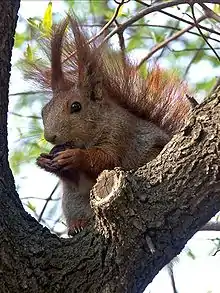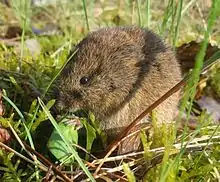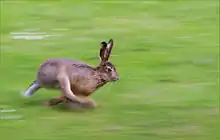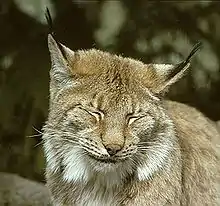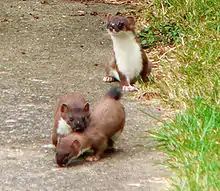List of mammals of North Macedonia
This list shows the IUCN Red List status of the 56 mammal species occurring in North Macedonia. Nine are vulnerable and three are near threatened. The following tags are used to highlight each species' status as assessed on the respective IUCN Red List published by the International Union for Conservation of Nature:
| EX | Extinct | No reasonable doubt that the last individual has died. |
| EW | Extinct in the wild | Known only to survive in captivity or as a naturalized populations well outside its previous range. |
| CR | Critically endangered | The species is in imminent risk of extinction in the wild. |
| EN | Endangered | The species is facing an extremely high risk of extinction in the wild. |
| VU | Vulnerable | The species is facing a high risk of extinction in the wild. |
| NT | Near threatened | The species does not meet any of the criteria that would categorise it as risking extinction but it is likely to do so in the future. |
| LC | Least concern | There are no current identifiable risks to the species. |
| DD | Data deficient | There is inadequate information to make an assessment of the risks to this species. |
Order: Rodentia (rodents)
Rodents make up the largest order of mammals, with over 40% of mammalian species. They have two incisors in the upper and lower jaw which grow continually and must be kept short by gnawing. Most rodents are small though the capybara can weigh up to 45 kg (99 lb).
- Suborder: Sciurognathi
- Family: Sciuridae (squirrels)
- Subfamily: Sciurinae
- Tribe: Sciurini
- Genus: Sciurus
- Red squirrel, S. vulgaris LC[1]
- Genus: Sciurus
- Tribe: Sciurini
- Subfamily: Xerinae
- Tribe: Marmotini
- Genus: Marmota
- Alpine marmot, M. marmota LC
- Genus: Spermophilus
- European ground squirrel, Spermophilus citellus VU
- Genus: Marmota
- Tribe: Marmotini
- Subfamily: Sciurinae
- Family: Gliridae (dormice)
- Subfamily: Leithiinae
- Genus: Dryomys
- Forest dormouse, Dryomys nitedula LC
- Genus: Eliomys
- Garden dormouse, Eliomys quercinus VU
- Genus: Muscardinus
- Hazel dormouse, Muscardinus avellanarius LC
- Genus: Dryomys
- Subfamily: Glirinae
- Genus: Glis
- Edible dormouse, Glis glis LC
- Genus: Glis
- Subfamily: Leithiinae
- Family: Spalacidae
- Subfamily: Spalacinae
- Genus: Nannospalax
- Lesser mole rat, Nannospalax leucodon LC
- Genus: Nannospalax
- Subfamily: Spalacinae
- Family: Cricetidae
- Subfamily: Arvicolinae
- Genus: Arvicola
- European water vole, Arvicola terrestris LC
- Genus: Chionomys
- Snow vole, Chionomys nivalis LC
- Genus: Clethrionomys
- Bank vole, Clethrionomys glareolus LC
- Genus: Dinaromys
- Balkan snow vole, Dinaromys bogdanovi VU
- Genus: Microtus
- Common vole, Microtus arvalis LC
- Felten's vole, Microtus felteni DD
- Günther's vole, Microtus guentheri LC
- European pine vole, Microtus subterraneus LC
- Thomas's pine vole, Microtus thomasi LC
- Genus: Arvicola
- Subfamily: Arvicolinae
- Family: Muridae (mice, rats, voles, gerbils, hamsters, etc.)
- Subfamily: Murinae
- Genus: Apodemus
- Yellow-necked mouse, Apodemus flavicollis LC
- Wood mouse, Apodemus sylvaticus LC
- Genus: Micromys
- Eurasian harvest mouse, Micromys minutus LC
- Genus: Mus
- Macedonian mouse, Mus macedonicus LC
- Steppe mouse, Mus spicilegus
- Genus: Apodemus
- Subfamily: Murinae
- Family: Sciuridae (squirrels)
Order: Lagomorpha (lagomorphs)
The lagomorphs comprise two families, Leporidae (hares and rabbits), and Ochotonidae (pikas). Though they can resemble rodents, and were classified as a superfamily in that order until the early 20th century, they have since been considered a separate order. They differ from rodents in a number of physical characteristics, such as having four incisors in the upper jaw rather than two.
- Family: Leporidae (rabbits, hares)
- Genus: Lepus
- European hare, L. europaeus LC[2]
- Genus: Lepus
Order: Soricomorpha (shrews, moles, and solenodons)


The "shrew-forms" are insectivorous mammals. The shrews and solenodons closely resemble mice while the moles are stout-bodied burrowers.
- Family: Soricidae (shrews)
- Subfamily: Crocidurinae
- Genus: Crocidura
- Bicolored shrew, C. leucodon LC
- Lesser white-toothed shrew, C. suaveolens LC[3]
- Genus: Crocidura
- Subfamily: Soricinae
- Tribe: Nectogalini
- Genus: Neomys
- Southern water shrew, Neomys anomalus
- Eurasian water shrew, Neomys fodiens
- Genus: Neomys
- Tribe: Soricini
- Genus: Sorex
- Alpine shrew, Sorex alpinus
- Common shrew, Sorex araneus
- Genus: Sorex
- Tribe: Nectogalini
- Subfamily: Crocidurinae
Order: Chiroptera (bats)
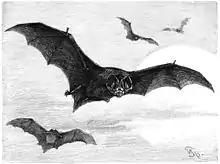
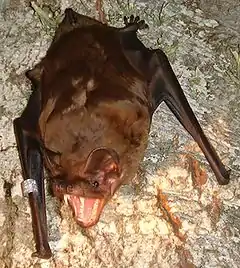
The bats' most distinguishing feature is that their forelimbs are developed as wings, making them the only mammals capable of flight. Bat species account for about 20% of all mammals.
- Family: Vespertilionidae
- Subfamily: Myotinae
- Genus: Myotis
- Bechstein's bat, Myotis bechsteini VU
- Long-fingered bat, Myotis capaccinii VU
- Geoffroy's bat, Myotis emarginatus VU
- Genus: Myotis
- Subfamily: Vespertilioninae
- Genus: Barbastella
- Western barbastelle, B. barbastellus NT[4]
- Genus: Nyctalus
- Greater noctule bat, Nyctalus lasiopterus LR/nt
- Lesser noctule, Nyctalus leisleri LR/nt
- Genus: Pipistrellus
- Common pipistrelle, Pipistrellus pipistrellus LC
- Genus: Barbastella
- Subfamily: Miniopterinae
- Genus: Miniopterus
- Schreibers' long-fingered bat, Miniopterus schreibersii LC
- Genus: Miniopterus
- Subfamily: Myotinae
- Family: Rhinolophidae
- Subfamily: Rhinolophinae
- Genus: Rhinolophus
- Mediterranean horseshoe bat, Rhinolophus euryale VU
- Greater horseshoe bat, Rhinolophus ferrumequinum LR/nt
- Lesser horseshoe bat, Rhinolophus hipposideros LC
- Mehely's horseshoe bat, Rhinolophus mehelyi VU
- Genus: Rhinolophus
- Subfamily: Rhinolophinae
Order: Carnivora (carnivorans)

There are over 260 species of carnivorans, the majority of which feed primarily on meat. They have a characteristic skull shape and dentition.
- Suborder: Feliformia
- Family: Felidae (cats)
- Subfamily: Felinae
- Genus: Felis
- European wildcat, F. silvestris
- Genus: Lynx
- Eurasian lynx, L. lynx LC[5]
- Genus: Felis
- Subfamily: Felinae
- Family: Felidae (cats)
- Suborder: Caniformia
- Family: Canidae (dogs, foxes)
- Family: Ursidae (bears)
- Genus: Ursus
- Brown bear, U. arctos LC[9]
- Genus: Ursus
- Family: Mustelidae (mustelids)
- Genus: Lutra
- European otter, L. lutra NT[10]
- Genus: Martes
- Beech marten, M. foina LC[11]
- Genus: Meles
- Eurasian badger, M. meles LC[12]
- Genus: Mustela
- Stoat, M. erminea LC
- Least weasel, M. nivalis LC
- European polecat, M. putorius LC
- Genus: Vormela
- Marbled polecat, V. peregusna VU
- Genus: Lutra
Order: Artiodactyla (even-toed ungulates)
The even-toed ungulates are ungulates whose weight is borne about equally by the third and fourth toes, rather than mostly or entirely by the third as in perissodactyls. There are about 220 artiodactyl species, including many that are of great economic importance to humans.
- Family: Suidae (pigs)
- Family: Cervidae (deer)
- Subfamily: Cervinae
- Genus: Cervus
- Red deer, C. elaphus LC
- Genus: Dama
- Fallow deer, D. dama LC introduced
- Genus: Cervus
- Subfamily: Capreolinae
- Subfamily: Cervinae
- Family: Bovidae (cattle, antelope, sheep, goats)
Extirpated
- European bison, Bison bonasus[13]
- Lion, Panthera leo[14]
See also
References
- Amori, G.; Hutterer, R.; Kryštufek, B.; Yigit, N.; Mitsain, G.; Muñoz, L. J. P. (2010). "Sciurus vulgaris". IUCN Red List of Threatened Species. 2010: e.T20025A9136220.
- Hacklande, K. & Schai-Braun, S. (2019). "Lepus europaeus". IUCN Red List of Threatened Species. 2019: e.T41280A45187424.
- Hutterer, R.; Amori, G.; Krystufek, B.; Yigit, N.; Mitsain, G. & Palomo, L.J. (2010). "Crocidura suaveolens". IUCN Red List of Threatened Species. 2010: e.T29656A9511068.
- Piraccini, R. (2016). "Barbastella barbastellus". IUCN Red List of Threatened Species. 2016: e.T2553A22029285.
- Breitenmoser, U.; Breitenmoser-Würsten, C.; Lanz, T.; von Arx, M.; Antonevich, A.; Bao, W. & Avgan, B. (2015). "Lynx lynx". IUCN Red List of Threatened Species. 2015: e.T12519A121707666.
- Hoffmann, M.; Arnold, J.; Duckworth, J. W.; Jhala, Y.; Kamler, J. F. & Krofel, M. (2018). "Canis aureus". IUCN Red List of Threatened Species. 2018: e.T118264161A46194820.
- Boitani, L.; Phillips, M. & Jhala, Y. (2018). "Canis lupus". IUCN Red List of Threatened Species. 2018: e.T3746A119623865.
- Hoffmann, M.; Sillero-Zubiri, C. (2016). "Vulpes vulpes". IUCN Red List of Threatened Species. 2016: e.T23062A46190249.
- McLellan, B. N.; Proctor, M. F.; Huber, D. & Michel, S. (2017). "Ursus arctos". IUCN Red List of Threatened Species. 2017: e.T41688A121229971.
- Roos, A.; Loy, A.; de Silva, P.; Hajkova, P. & Zemanová, B. (2015). "Lutra lutra". IUCN Red List of Threatened Species. 2015: e.T12419A21935287.
- Abramov, A.V.; Kranz, A.; Herrero, J.; Krantz, A.; Choudhury, A. & Maran, T. (2016). "Martes foina". IUCN Red List of Threatened Species. 2016: e.T29672A45202514.
- Kranz, A.; Abramov, A. V.; Herrero, J. & Maran, T. (2016). "Meles meles". IUCN Red List of Threatened Species. 2016: e.T29673A45203002.
- Douglas, N. (1927). Birds and Beasts of the Greek Anthology. Florence.
- Cohen, A. (2010). Art in the era of Alexander the Great: Paradigms of manhood and their cultural traditions. Cambridge: Cambridge University Press. pp. 68–69. ISBN 978-0-5217-6904-4.
External links
- "Animal Diversity Web". University of Michigan Museum of Zoology. 1995–2006. Retrieved 22 May 2007.
